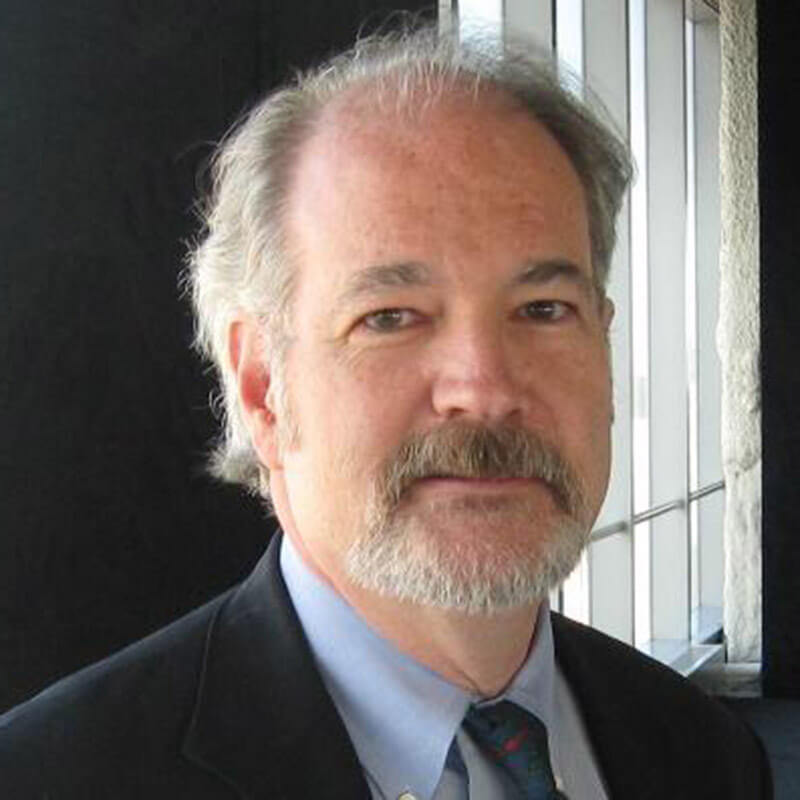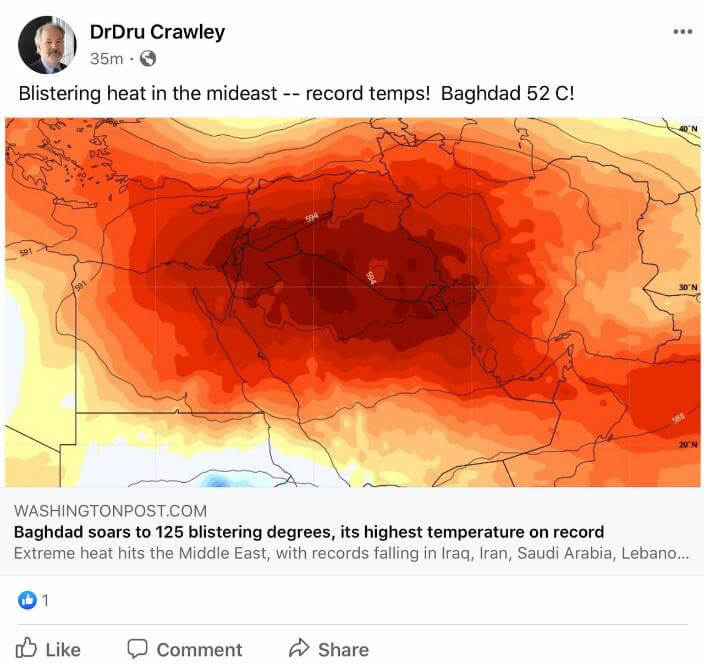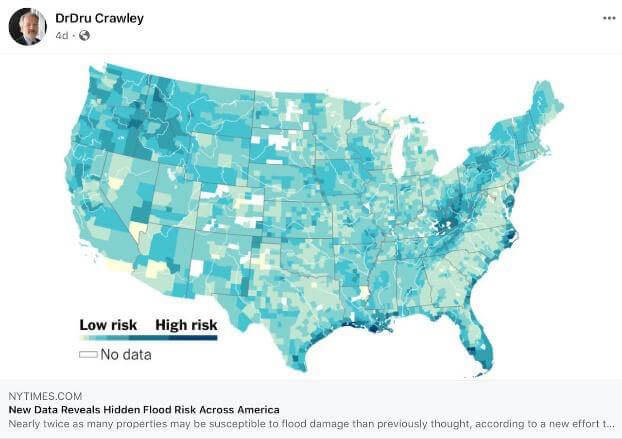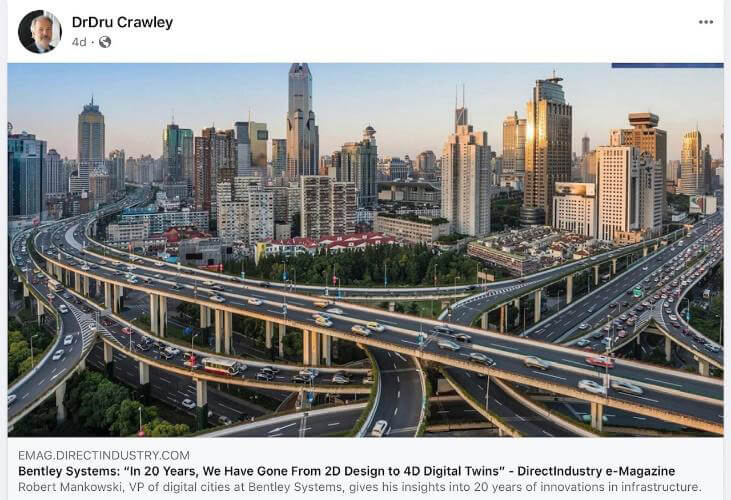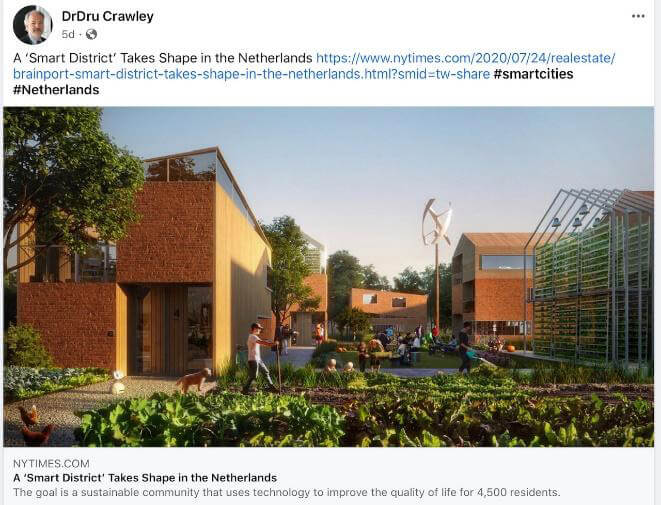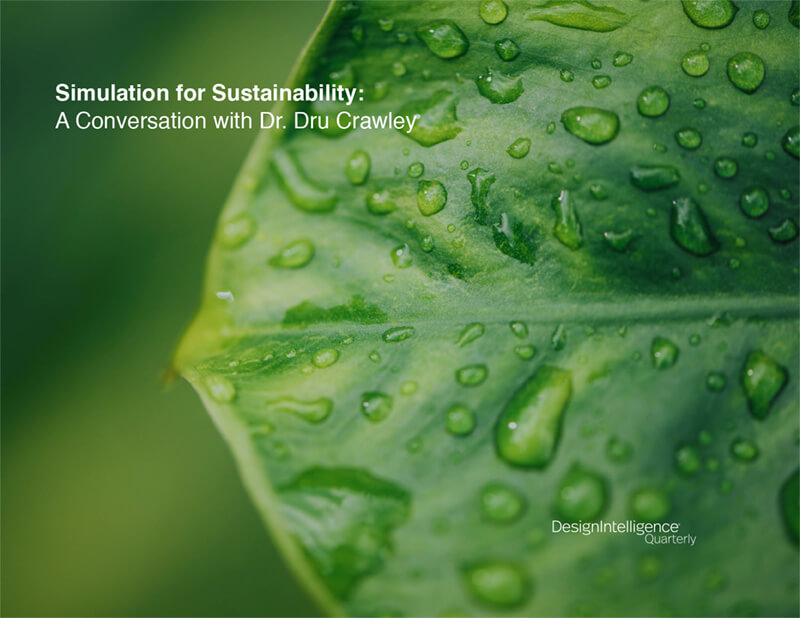Simulation for Sustainability:
A Conversation with Dr. Dru Crawley
by Dr. Dru Crawley
Ph.d., FASHRAE, BEMP, FIBPSA, AIA is Bentley Fellow and Director, Building Performance at Bentley Systems Inc. Vice-president of
IBPSA, President of IBPSA-USA, AIA and ASHRAE, and recipient of the President’s Volunteer Service Award
Data modeling can change behavior. In this discussion, Bentley Fellow Dr. Dru Crawley discusses simulation, digital twins, and 5G — and revives an old idea for higher performing, sustainable buildings, infrastructures, and cities: designing for flexibility and adaptability.
DesignIntelligence (DI): Thank you for joining us. It’s wonderful to reconnect after all these years. I remember working together when you were with the Heery Energy Company in 1981. That’s 40 years ago, before the PC and the Internet. That was a pioneering role. What was the vision for that group, and what drew you there?
Dru Crawley (DC): I was working for AIA Research right out of college. The opportunity at Heery Energy appealed to me because it was a small, growing group doing interesting work. They were doing simulations, something I had done in college. After a year and a half in Washington dealing with the politics, I didn’t want to deal with it anymore, so Atlanta seemed like a good idea.
DI: The theme of this issue is redefining. Your foresight and early work in the energy industry shows an inclination to do that as a scholar and practitioner. I remember collaborating on what we called “energy conservation opportunities.” For example, does this option affect the building orientation? Should the project have an atrium for passive ventilation or not, and options analyses for HVAC and electrical systems? While those things may not have redefined those projects, they shaped them.
But we didn’t have the kind of interactive visualization and simulation tools you have been developing. We were using dot matrix printers. In your experience, has the shift to things like generative components, machine learning, and simulation had an impact on how we design, or use data to inform design?
DC: It has. We see more interesting buildings now. Generative components have made that possible. You can use algorithms to define shapes and create new ways of doing things. Similarly, the computational powers now exist to let you do multi-disciplinary evaluation and optimization of shapes, systems, and other design aspects.
The data itself is becoming transformative. We’ve rarely had enough data to understand how our buildings use data or understand how cities are using it. Now, there are 25 U.S. cities that have benchmarking. If your building is over a certain floor area, say 50,000 square feet, you’re required to publish utility bills for electricity, natural gas, water, and everything related. That data is publicly available, and we’ve seen cities where this has had an informative and transformative affect.
In Chicago, where they’ve been doing it for seven years, the energy use of the buildings in the data set is coming down. That’s partly because the measurement challenges, informs, and begs questions. They can look at a building next to them they had no idea about and ask “Why is that building using half the energy of my building? What’s different?” So, having that data is transformative.
DI: You’re able to observe and measure that the data is changing behavior?
DC: Absolutely. The most interesting data transformation is going to be is the real time data we’ll get because of new network technologies like 5G and beyond. Their lack of latency is going to provide instantaneous access to data. That allows us to have more mobile connections collecting data from a lot more places. The Internet of things, Smart cities, all of that is going to be enabled by having access to that data. That’s going to move us forward quickly.
DI: Beyond my cell phone or wireless network, for the lay person, what does this mean? Is it just faster, with less latency?
DC: It will be faster, but the benefit is instantaneous response. Now, if you do a speed check on your Internet connection, there’s a millisecond response delay from a web page or device. In the future that access should be instantaneous. That allows you to control things that require very quick response. It’s going to revolutionize controls – and lots of other things.
Cities are looking to collect data about transportation. Trying to make streets and transportation easier during commutes, and being able to redirect traffic in certain ways, and be able to make decisions in real time. That’s going to be a game changer in the industry.
How that does in buildings, we’ll see, but I could imagine where you no longer have to wire a controls device. It could be a wireless device instead. One of the problems we’ve always had with controls, is that the little devices, like thermostats sensing or controlling, are not that expensive. It used to cost $20.00 for the controller, and then $100.00 to wire it back to the central processing unit. If we can eliminate that part, we can have more ability to control and make our buildings more comfortable and safer.
DI: We know buildings are a big contributor to energy consumption. It’s one thing to improve one building’s performance, drive an electric vehicle, recycle your waste, or make some small improvement. But now that you’re talking on the scale of cities, that broader scale systematic infrastructure potential is where the impact is. Let talk about what Bentley is doing in that regard.
30 years ago, Bentley was the robust software system of choice for most architects. Over three decades I’ve seen you migrate from the mass market in architectural design to the engineering and infrastructure community. I’m astounded at the number of software solutions your company has. What are some new things your software is doing now that the average person might not know about?
DC: Bentley’s tag line is, “Advancing Infrastructure,” so we see our software as an enabler for not only design and construction, but operation and asset management. We have a whole suite of products. We’re not just BIM. BIM is a relatively small part of our revenue stream. We’re doing massive infrastructure projects. The new Elizabeth Line through the center of London is 40 miles of new tunnel built within 18 inches of other existing, operating tunnels. We can do that with precision. All the design documentation was Cloud based, using Bentley Software. Structural, bridge, rail, and large infrastructure projects are a focus for us these days.
That doesn’t mean we don’t have BIM. We do, and we have, as you said, a very robust product, but it’s evolving. Our BIM platform works throughout all built infrastructure, so you can be with the same platform designing a building, a bridge, a subway station, or anything. They’re separate products for specific purposes but it’s the same platform.
Our focus of late is digital twins. The idea is we have not only the design and the as-builts, but data that represents the building. It could be a way to operate it. It could be a way to do analysis, all sorts of aspects, so there’s essentially a digitized version of the infrastructure or element. We are looking at ways of collecting data. Our platform can do traditional 3D objects, but we also can take in mesh and point cloud data, so you can go to the field and collect data using Lidar, and that can be part of your model. Or you can collect a few thousand photographs and create a 3D model of it using photogrammetry. We have lots of ways of getting data. It’s not just a design tool anymore. We have 4D, 5D, 6D, and even 7D at this point. Cost, operation, FM assets data, and all the aspects beyond geometry and time.
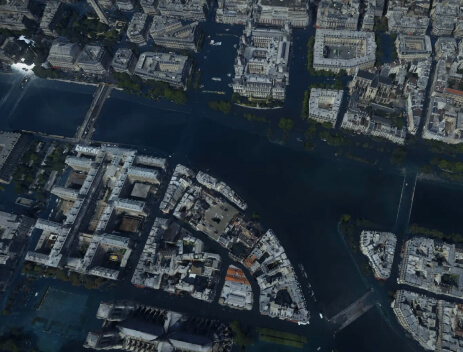
DI: Those are great examples. I saw one when I spoke at one of your annual conferences in Baltimore years ago. Up on the screen was a 3D digital model of an entire municipal water system. It showed the geometry, layout, flow rates, problems, leaks, data, controls, and operation. That was mind blowing to think somebody could model all that data at an infrastructure level. Has Bentley has ever aspired to take infrastructure down to an individual, residential, or commercial level?
DC: Our software is used widely for doing infrastructure at the building scale as well. We can model the mechanical, electrical, water, or any system. We had an acquisition about three years ago, where they modeled the drainage system. The company was founded in Lisbon, and they had a model of the city showing, if they had a 100-year flood or rainfall, or a 500-year event, what’s going to happen to the drainage? Where are they going to have problems? Where is it going to be backed up? You can simulate that because you have a 3D model of the city, and the underlying infrastructure.
I saw a recent 3D model of Paris built from photogrammetry. The ability to model that and see exactly at what level, if the city floods, are certain banks going to go underwater? How far is it going to reach back into the city? They can study and learn that to an accuracy of 100 centimeters or less to influence retaining wall and bank top design to prevent flooding. That becomes obvious once you have a way to simulate and visualize it.

DI: In significant ways, the ability to see and access simulations changes how we see, think, and design. When you go down to the level of an individual looking at who’s dropping an Amazon package at their doorstep, or controlling their thermostat remotely, that kind of access is powerful.
DC: Exactly. It is amazing what’s possible now, and what’s happened in the last few years. I give talks about future building and market trends. One of the examples I use is my cell phone. I hold it up and say, “This is more powerful than the mainframe computer it was talking to 40 years ago. This has more capability — and I can use it as a phone too.”
DI: That’s a good example. Having reflected on your career evolution, now we face this astounding year of concurrent crises. So, let’s shift to a future view. I know from your prolific social media output that you keep your finger on the pulse of countless environmental issues. Where should designers, builders, and owners direct their attention to improve building performance and sustainability? Is that a tough question?
DC: It is, and it isn’t. I think about this a lot. One of my roles as a fellow is to keep my finger on the pulse of what’s going on and look for new, interesting things happening — or ones that aren’t and should be. I’ve concluded that one of the things we can best do as designers, to support what may happen in the future, is to design flexibility into our buildings. To have the ability to consider changing them later.
Stewart Brand wrote a great book called How Buildings Learn. He has a wonderful quote: “Every building is a prediction. Every prediction is wrong.” His thesis is that we start changing our buildings to match our needs the moment we occupy them. They’ll change. They’ll need to change – in reasonably easy ways. Ways that can support us for energy efficiency, going to net zero, sustainability, resilience, all the buzz words. There’s a powerful need for buildings that can accommodate such flexibility.
The cover of the book has a picture of twin buildings built in the 1800’s. They look identical. Then, looking at them 150 years later, you couldn’t tell they were related, much less identical twins, because one’s got a new floor and it’s got wrought iron on it. The other one had gone classical. They’re still right next to each other, but you would never have known they were the same floor plan, layout, and structure.
We forget that sometimes our buildings need to change. They don’t meet our needs. How we use them will change, and flexibility is something we leave out. We over-design, make things overly specific and don’t give future use a consideration. Is that sustainable? No.
DI: That’s a fascinating observation, particularly in 2020. I’ve dabbled in what you’re suggesting in past lives as a designer. We were trying to design structures that might last 50 or 100 years, HVAC systems that might last 20 or 30 years then need upgrading, and interiors that would need refreshing or to accommodate changing programs every 2 to 5 years. Flexibility and adaptability are such underappreciated values for owners, because they’re too often myopically focused on, “I have to meet a first cost budget,” or, “I’m a developer, I just want to flip this building in a year. It’s not my problem.”
Well, I hope they’re learning some lessons. At DesignIntelligence, we’re focused on capturing the opportunity for transformation this crisis is giving us. Colleague Bob Fisher says, “in a crisis the first thing that’s lost is perspective.” Perspective is what you’re talking about.
Our responsibility should be to give program and design decisions a longer time horizon. That’s obvious in this time of COVID and other crises, because everything we “knew” seems to be wrong, or at least uncertain. Do we still have a job? Do we still need our office space? Can we re-purpose it? Can we modify the HVAC system to prevent spread of the virus? Designing for adaptability, uncertainty, and change is THE key strategy for sustainability. I love that observation, and I think Charles Darwin would agree.
DC: Right. Back in May people were saying, “I like working from home. This is really good,” but by July, people are saying, “I really need to go back. Somewhere else that’s not home, that’s a separate place.” I think we’ll eventually make it back. We’ve struggled with epidemics in the past. Fortunately, we have always come back. This happened 100 years ago, with the Spanish Flu. It shut large chunks of the country down. Today we’re still functioning, because we’re able to do what you and I are doing right now, have calls and still function. Even 10 years ago this would have been more devastating, because there just wasn’t the capability that we have now. Electronics have evolved to support us.
DI: Our CEO, Dave Gilmore, just recommended a book by Steven Pinker called Enlightenment Now. The book tracks data, science, and trends to show we have many reasons for optimism. People who aren’t data-driven wrongly say, “Everything’s horrible. It’s worse than ever. It’s declining and we’re failing.” Pinker demonstrates in every category that the data say otherwise.
You cover a lot of similar ground in your role, a whole host of issues from buildings to infrastructure. In your role as a fellow doing research and education, is there a parallel for the rest of us as we evolve to be smarter about these things we’re talking about. Can you talk about your role?
DC: Sure. My role as a fellow is partly thought leadership and sharing through presentations. Despite COVID, I’ve done 25 presentations so far this year, both live and virtual. Bentley encourages me to speak. One aspect is sharing vision and information I’m learning. Also, keeping my finger on the pulse to see where things are headed. The third aspect is research. I’m not doing a lot of research personally. I’m doing some work on climate, but more working with universities where we are sponsoring or co-sponsoring research projects. We also sponsor PhDs in a number of universities. We are broadening that and looking for people interested in digital twins. That’s the focus: what’s a new way we can do this?
I’m working with the University of Texas right now. They have made a proposal to create a digital twin of their whole campus to look at energy flows. The professors are trying to de-carbonize their campus. They have a problem: they’re going to add another 2 million square feet and they’re going to need an additional power plant. They’re looking to see if they can use the model to optimize what they have and identify areas where — through storage, energy efficiency, and renewables — they can reduce the need for that central plant.
We’re also working with a university in India. They are capturing some 450 square kilometers to create a digital twin of the whole city. From there, they’ll create energy simulation models of every building. Using machine learning, they can identify elements and automatically tell if it’s a roof, a door, or a window. What are the parts of the building, so they can start breaking them apart? Not just a mesh model, but a 3D model with metadata. We have other projects going on, but those are the two biggest right now.
DI: You’re doing those as commissioned, purposed, applied research support services for those customers?
DC: In those cases, we’re a partner. Their researchers perform most of the work. We provide software and access to our experts, particularly in the AI side of things.
DI: More of a mutual sharing?
DC: Right. For cases where we’re working with PhD students, we are not paying their expenses, but we’re a partner. They often have pooled resources from governmental access as well. The opportunities I’m looking for are all related to building performance and looking at how smart cities and anything related to performance in the built environment. I’m trying to direct the universities and professors I’m working with toward that.
DI: Let’s explore that. Most of the business world is transactional. You sell me some services, and I pay you. I might not care about the future or responsibilities to society. In your work as a fellow doing research, do you feel pressured — as you make these discoveries or encounter cutting edge things — to productize and monetize them? You’re shaking your head no, so that confirms what I thought. That’s an interesting model that’s emerged over the past few decades of open sharing, and collaboration. Things like freeware, shareware, and Wikipedia where people have an idea and put it out there for the common good, in the hopes they might get something back in the future.
I’m assuming a company like Bentley makes their money in other areas. You’re being funded somehow, as an R&D guy in a different sector. I was lucky enough late in my career to have a similar role, where part of my charge was to look ahead, be a change agent and give back. The average Joe, working week to week doesn’t have the luxury of thinking that way.
DC: It’s unique, I haven’t run into anybody with a similar role. Normally, my research is for something at least two years
out, to get the research done in time to have a product offer.
The conference you mentioned, the one you talked at in Baltimore, has now been converted to a C-Suite event. It’s now called “A Year in Infrastructure.” Last October, it was in Singapore. They’ve been rotating the location. It was in Philly for a while, then about seven years ago, they started doing it in London, and three years ago, in London and Singapore. This year it was supposed to be in Vancouver, but it’s going virtual. That is an event where our users get to show the world what they’ve done with our software, and so we’re promoting the users. They get to come to a big party, and all that, but they’re also able to make presentations about their innovations. We share amazing work from around the world.
Bentley doesn’t expect any direct immediate payback from the work I do, because it’s five to seven years out for a lot of it. But if we can use some of it to empower software or customers, that gives our product managers ideas about where they can take their software in the future and what they might need to support it. I think the pure research is a win for the company, but as my boss reminds me, sometimes we have to show what we do that makes it worthwhile for us to keep doing it and show the outcomes of the research. I still can’t believe they let me do whatever I want to do. It feels that way some days.
DI: You earned the privilege, and I’m sure there are plenty of other, more challenging things that offset that freedom. It can be tough setting priorities when you have no direction or product deadlines given to you. To bring this full circle, let’s close with a two-part question.
First, there’s so much discussion in our industry about what’s wrong with our fragmented processes. I have a bias – and supporting experience – that most owners I’ve worked with have been misdirected. They’re working on first cost budgets and their process and project delivery approach are flawed. We’re still designing projects where the designer has an idea, then we bring on some engineers to force the HVAC systems into the project, and maybe we’ll apply some sustainability and energy analysis. A rare handful of projects are doing that together, in an integrated way at the start, and changing how they work. That’s my experience over 40 years of practice with multiple firms. Does that match your experience?
DC: It does.
DI: OK, if so, how would you go about it in an ideal scenario? Who’s in the room? What do we do? How do we refocus the goals?
DC: The most interesting projects I’ve had were the ones with an engaged owner. Owner-occupied projects. If it was a building they were going to occupy, they started to think beyond pure first cost. In owner-occupied projects they have self-interest. Sure, there are probably separate budgets for capital and ongoing operations, but the line blurs when you can say, “If you want to save money in the long term, it will keep getting more expensive. If we do this now, we can make this building as efficient as possible, maybe even get to zero energy.”

It’s funny, 15 years ago I was talking to my boss at the Department of Energy. I said, “You’re all about measurement. You really want to measure progress, but I don’t know how to measure ‘high performance.’ I don’t know what ‘high’ means.” He said, “Well then, come up with another metric,” and that’s when we started asking if we could go to zero. We realized we better do some analysis to see whether it’s even technically possible, knowing what we know. We were surprised. It was. And now I’m seeing large buildings operating at zero energy successfully. They’re going to pay those owners back forever. Their costs are substantially lower. The total cost of ownership is going to be much better for them.
Another barrier we traditionally face is, “Oh, we can’t really do anything more than a three year pay back.” If you start to look at, “Let’s go as far as we can and see what that’s going to cost.” A lot of zero energy buildings don’t cost any more than a traditional building, because we’ve downsized the systems and operating equipment so the total cost is lower. We have better envelopes, better integration, natural flows, maybe natural ventilation and daylighting, that take advantage of all those opportunities at the same time.
DI: That is clear incentive — an ideal situation where an owner occupies their building because they care. It’s theirs, and they have a long-term perspective. I’ve had the good fortune to work for a few clients who aspired to and achieved that. Like the folks at Apple at their new Apple Park campus, and the Mercedes-Benz Stadium in Atlanta. It’s one of the most sustainable sports facilities in North America. For the sake of devil’s advocacy, I’ll go back to your earlier statement about flexibility. In a world with as much uncertainty as we’re facing, might there be fewer owners who can afford the risk of owning their own facility? Developers and landlords have always borne that risk. How do we challenge those of us who need the flexibility you suggest – of non-ownership – to stay liquid and nimble? Because I can certainly see a scenario of less ownership. How do we change the mindsets of the people who aren’t those ideal owners?
DC: It’s tough. One of the things I learned at the Department of Energy was to understand the client’s business model to be able to effectively work with them. If we always talk about “per square foot,” they’re not going to listen. That’s not how a lot of businesses work. If it’s a hotel, they’re interested in revenue per occupied room. That’s their metric. If it’s a school, “per square foot” doesn’t mean a thing. It’s “how many students can I get in there,” and “what is it going to cost me to build and operate that building per student?” That’s a much better metric for them.
DI: Maybe one answer, now that we’re measuring more and have data, is that hotel metric — as offset or penalized by carbon emissions, carbon tax, or societal penalties — now has a different outcome. If we can share that data, maybe your work and others’ doing measurement and analysis will pay off. But as you say, knowing your business and putting things in their language are a must.
DC: It takes some leading-edge people to take the risk and do the documentation. The National Renewable Energy Lab has been in operation for 10 years. Their research support facility is a 330,000 square foot, zero-energy building. It has a data center and all sorts of other things. They’ve operated that building successfully for the last 10 years. The worst capital cost scenario is working for the federal government. You have a fixed budget appropriated by Congress and that’s all the money there is. They were able to accomplish those things within that budget.
DI: Those case studies give the rest of us hope. Thank you for being one of those leading-edge people — and for being willing to share it with us. I think this is going to be a valuable discussion. Hopefully we can keep the conversation going.
DC: Happy to do it. Thank you, Michael.
Dru Crawley, Ph.d., FASHRAE, BEMP, FIBPSA, AIA is Bentley Fellow and Director, Building Performance at Bentley Systems Inc., where he is a thought leader focusing on building performance, BIM, zero-energy buildings, interoperability, smart cities, and sustainability, responsible for Bentley-sponsored research relating to decarbonization using digital twins. Before joining Bentley in 2010, Dr. Crawley developed, launched, and managed USDOE’s Commercial Building Initiative — zero-energy commercial buildings (now Better Buildings) — and created the EnergyPlus energy simulation design tool. He has early experience with Heery Energy Consultants, a division of Heery International, and has served as a lecturer at the University of Wellington and as an independent consultant in Washington D.C.
He has authored the following papers: Getting to Net Zero; Building Performance Simulation: A Tool for Policymaking; Estimating the Impacts of Climate Change and Urbanization on Building Performance; Understanding Zero-Energy Buildings; Contrasting the Capabilities of Building Energy Performance Simulation Programs; EnergyPlus: Creating a New-Generation Building Energy Simulation Program; Improving the Weather Information Available to Simulation Programs; Which Weather Data Should You Use for Energy Simulations of Commercial Buildings?; Energy Simulation in the Building Design Process.
Dr. Crawley holds a Bachelor of Architecture from the University of Tennessee and a Ph.D. in Mechanical Engineering from the University of Strathclyde in Glasgow, Scotland. He is an active member and vice-president of the International Building Performance Simulation Association (IBPSA), president of IBPSA-USA, American Institute of Architects (AIA) and the American Society of Heating, Refrigeration, and Air Conditioning Engineers (ASHRAE), and is a past recipient of the President’s Volunteer Service Award. His current focus is using digital twins for researching building performance.

